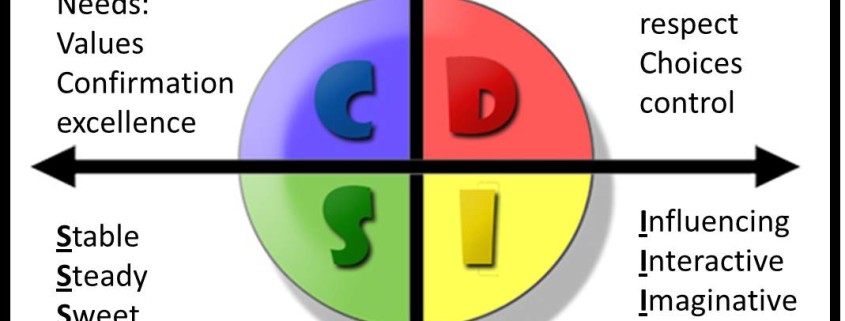The DISC Profile: Placing People on the Map
When I was growing up and even through most of my undergrad years, I always thought that EVERYONE was competitive. I thought everyone played nature’s game. However, when I was taking an OLS class in 2004, I found out about personality temperaments. Specifically, I found out about the Myers-Briggs Personality Profile test. While studying this I came to find out that there were 16 combinations of 8 different traits that a person could have. At the time, I thought it was preposterous to label people – but as I had to study it more, I found out that it explained quite a bit.
Well, over time, I became frustrated with the Myers-Briggs test (which is the same thing as the Jungian 16 test). In one week, I could be one of the 16 different combinations and then in the next week, I’d be another. I could be an introvert one week and the next week, I’d be an extrovert!
Well eventually I ran across a book called Personality Plus. In this book, Florence Littauer explains how there are really four main personality temperaments: the Melancholy, Phlegmatic, Sanguine, and Choleric. She also explains how to tell what you are as well as what others are and how to interact with them.
Later, I found out about the DISC personality assessment and realized that the temperaments described in Florence’s book could have easier names to remember! DISC is short for Dominant, Imaginative, Supportive, and Calculative (or a combination of similar terms).
At any rate, the point of all of this is that once you have an understanding of what these temperaments are, you can understand where people are coming from. In a very basic form, you can understand what drives people. So, without further adue, here’s a brief explanation of the different DISC temperaments (source: Wikipedia):
The assessments classify four aspects of behavior by testing a person’s preferences in word associations (compare with Myers-Briggs Type Indicator). DISC is an acronym for:
- Dominance – relating to control, power and assertiveness
- Influence – relating to social situations and communication
- Steadiness (submission in Marston’s time) – relating to patience, persistence, and thoughtfulness
- Conscientiousness (or caution, compliance in Marston’s time) – relating to structure and organization
These four dimensions can be grouped in a grid with “D” and “I” sharing the top row and representing extroverted aspects of the personality, and “C” and “S” below representing introverted aspects. “D” and “C” then share the left column and represent task-focused aspects, and “I” and “S” share the right column and represent social aspects. In this matrix, the vertical dimension represents a factor of “Assertive” or“Passive”, while the horizontal dimension represents “Open” vs. “Guarded”.[2]
- Dominance (Choleric / Driver): People who score high in the intensity of the “D” styles factor are very active in dealing with problems and challenges, while low “D” scores are people who want to do more research before committing to a decision. High “D” people are described as demanding, forceful, egocentric, strong willed, driving, determined, ambitious, aggressive, and pioneering. Low D scores describe those who are conservative, low keyed, cooperative, calculating, undemanding, cautious, mild, agreeable, modest and peaceful.
- Influence (Sanguine / Expressive): People with high “I” scores influence others through talking and activity and tend to be emotional. They are described as convincing, magnetic, political, enthusiastic, persuasive, warm, demonstrative, trusting, and optimistic. Those with low “I” scores influence more by data and facts, and not with feelings. They are described as reflective, factual, calculating, skeptical, logical, suspicious, matter of fact, pessimistic, and critical.
- Steadiness (Phlegmatic / Amiable): People with high “S” styles scores want a steady pace, security, and do not like sudden change. High “S” individuals are calm, relaxed, patient, possessive, predictable, deliberate, stable, consistent, and tend to be unemotional and poker faced. Low “S” intensity scores are those who like change and variety. People with low “S” scores are described as restless, demonstrative, impatient, eager, or even impulsive.
- Conscientious (Melancholy / Analytical): People with high “C” styles adhere to rules, regulations, and structure. They like to do quality work and do it right the first time. High “C” people are careful, cautious, exacting, neat, systematic, diplomatic, accurate, and tactful. Those with low “C” scores challenge the rules and want independence and are described as self-willed, stubborn, opinionated, unsystematic, arbitrary, and unconcerned with details.
Who said you couldn’t source Wikipedia? 🙂
At any rate, I would like to note that while the DISC profile or any other personality temperament test can give a basic understanding of who a person is, it cannot possibly give an exact representation of who they are as a person. Why? Well think of a particular place on Earth, say Hawaii. Now it is possible to represent Hawaii by a Latitude and Longitude value but that probably doesn’t do it justice. There are so many ways that a particular place can be described, especially Hawaii, that limiting it to a few key words probably isn’t the best thing to do. The same thing is true with people.
So if you do start using the DISC profile (or any personality assessment) in common situations be careful that even if you get a base description of someone, that it isn’t all you use to evaluate who they are as person. But it definitely is a starting point… and that’s definitely better than nothing or just winging it!



I am curious to find out what blog platform you are utilizing?
I’m experiencing some minor security issues with my latest website and I’d like to find something more safeguarded.
Do you have any recommendations?
Hi Bell,
I’m currently utilizing thesis on wordpress – but will be upgrading to Thesis 2 soon.
For more information on Thesis 2, check out these videos on youtube:
https://www.youtube.com/user/ThesisVideoTutorials?feature=watch
Great piece of content. Keep it up with good work.